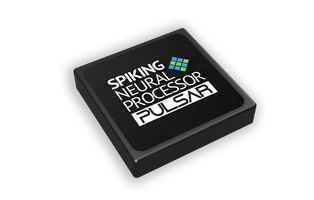Pulsar is a brain-inspired neuromorphic microcontroller designed for ultra-low-power, real-time intelligence in edge devices. It combines a Spiking Neural Network (SNN) engine with a RISC-V MCU and CNN acceleration to enable smart sensing applications without cloud dependency.
Developed By:
Overview
Pulsar is Innatera’s revolutionary brain-inspired microcontroller, engineered to deliver real-time, event-driven intelligence for a new generation of smart devices. As the world’s first commercially available neuromorphic processor for the mass market, Pulsar is designed to process sensor data with ultra-low power consumption, enabling “always-on” capabilities in wearables, IoT devices, and industrial systems without relying on the cloud.
The core of Pulsar’s innovation lies in its Spiking Neural Network (SNN) engine. Unlike traditional AI that continuously processes dense data, SNNs operate on event-driven spikes, activating compute power only when new information is available. This drastically reduces energy consumption to microwatt levels while achieving sub-millisecond inference speeds.
Architecture
Pulsar features a hybrid architecture that provides both efficiency and flexibility:
- Spiking Neural Network (SNN) Engine: The primary engine for processing sensor data like motion, audio, and vibration with maximum power efficiency.
- RISC-V MCU: A conventional microcontroller unit for general-purpose tasks and control.
- CNN Acceleration: Hardware support for Convolutional Neural Networks, offering versatility across different types of AI workloads.
This combination allows Pulsar to function as the sole microcontroller a sensor needs, integrating neuromorphic intelligence directly at the edge.
Software and Development
Development for Pulsar is streamlined through the Talamo SDK. This software development kit allows developers to:
- Create Spiking Neural Network models.
- Easily port existing models from popular frameworks like TensorFlow and PyTorch.
- Develop applications without requiring deep expertise in neuromorphic engineering.
This approach lowers the barrier to entry for building brain-inspired AI solutions.
Applications
Pulsar’s unique capabilities make it ideal for a wide range of power-constrained and latency-critical applications:
- Wearables & Hearables: Enabling always-on health monitoring, gesture recognition, and fall detection.
- Smart Home & IoT: Providing real-time event detection and environmental awareness without cloud reliance, enhancing privacy and responsiveness.
- Industrial Applications: Facilitating predictive maintenance and anomaly detection through ultra-efficient, continuous monitoring of machinery and systems.
Help Us Improve this Guide
Our hardware guide is community-maintained. If you know of a chip we should add, see an error, or have updated information, please let us know by opening an issue on our GitHub repository.







